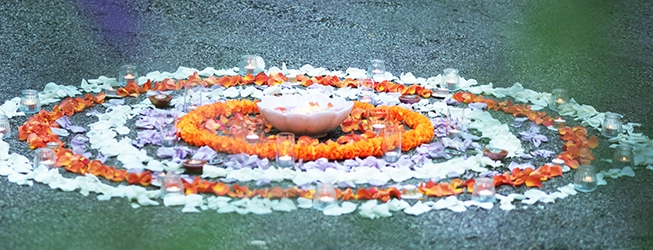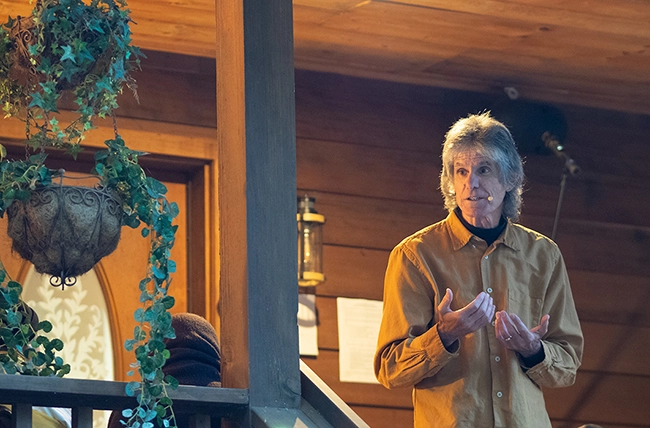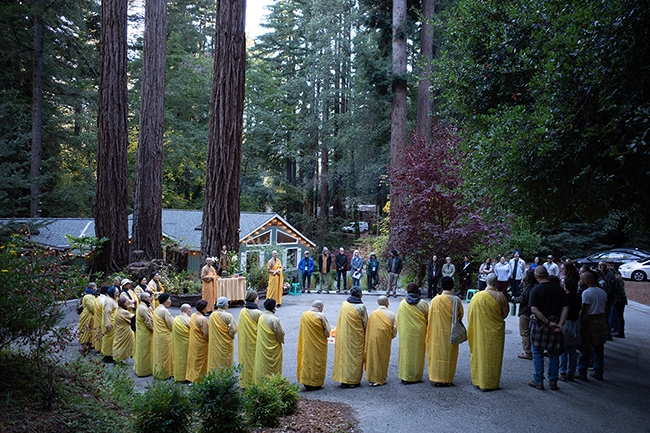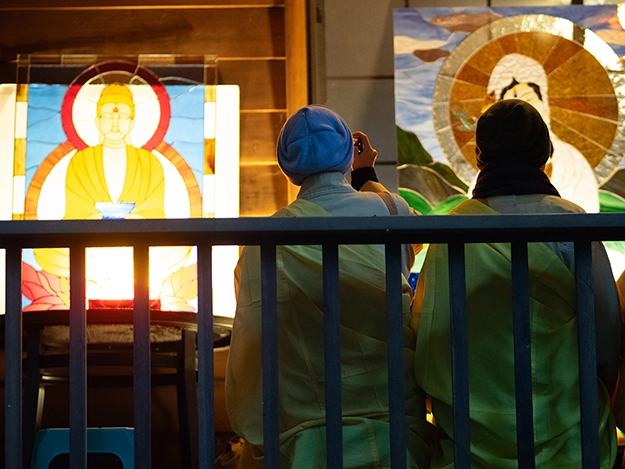By Redwood Vihara Chinese Translated by Janet Lee
紅木禪林 提供 李采眞 中譯 VBS 655

On the cold misty morning of November 10, 2024, nestled in the Santa Cruz mountains, Redwood Vihara came alive with a special gathering. The monastery hosted two significant events: the receiving of Buddha Shakyamuni and Venerable Master Xuyun’s sharira, and a purification ceremony for a newly offered building, Mudita House. The gathering drew a diverse group of monks, nuns, lay disciples, DRBU students, IGDVS graduates, and local neighbors.
2024年11月10日,在冬日霧晨中,位於聖塔克魯茲山巒的紅木禪林迎來一場盛會。禪林舉辦兩個重要活動:恭迎釋迦牟尼佛和虛雲老和尚的舍利,以及為一棟近期捐贈的Mudita喜苑舉行灑淨儀式。此次法會有四眾弟子、法界佛教大學(以下簡稱法大)學生、育良培德中學畢業生,和當地居民共襄盛舉。
Visitors were welcomed with a warm smile and offered their choice of hot beverages: Indian chai (the crowd favorite), barley tea, coffee, or hot water. The Indian chai, prepared by members of the Service Space community, embodied the spirit of care that permeated the whole space. From the “Compassion-In-Action” volunteers directing parking to those maintaining facilities and cleaning bathrooms, everyone shared the same wish to welcome everyone as family.
訪客受到暖心接待,並奉上可選擇的熱飲:印度奶茶(最受歡迎)、麥茶、咖啡及熱水。由服務空間社區成員所準備的印度奶茶體現出遍滿整個空間的關懷精神。志工們從指揮停車的「慈悲行」,到維護設施、清潔廁所,各個都懷著同樣的心願—將每位來賓作為家人款待。
The monastery’s story began in 1988 when Venerable Master Hua purchased the land with the intention of protecting its majestic redwoods. In the beginning years, Redwood Vihara was a quiet hermitage for solitary practice for monks. Over the last five years the monastery has developed with the intention of following Venerable Master Hua’s vow of bringing the Dharma to the West. This vision manifests by having programs and ceremonies primarily in English with traditional practices explained through modern interpretations, incorporating insights from Western philosophy, psychology, and science.
The natural setting of Redwood Vihara offers more than just a physical space—it provides a sanctuary for solitude, reflection, and meditation, offering a break from Silicon Valley’s often stressful pace. Here, visitors are encouraged to relax, take a deep breath, and “return to their nature in nature.”
禪林的故事始於1988年,當時宣公上人買下這塊土地,旨在保護這片雄偉的紅木林。紅木禪林最初是比丘法師的靜修蘭若。在過去五年中,禪林秉持宣公上人將佛法帶到西方的弘願發展。這一願景主要以英語進行的課程和法會體現,以符合現今的方式來詮釋傳統的修行方法,並融入西方哲學、心理學及科學的觀點。 紅木禪林不僅坐落於山林之間,更是一個能夠獨處、觀照和禪修的聖處,讓人們從矽谷緊湊的步調中得到喘息。在這裏,訪客可以放鬆身心、深呼吸,並「在大自然中回歸自性」。
The day began with Dharma Master Jin Chuan and Dharma Master JinWei leading a tour, during which neighbor Dan shared how Redwood Vihara survived the 2020 CZU Lightning Fire. He described arriving just in time to see fires approaching from three directions around the main building with the tool shed and carpark already burned. He went out to the highway and fortunately met a firetruck. Driving the firemen into the property, they created a firebreak that saved the monastery. Remarkably, the fire’s stopping point aligned exactly with where DRBA monastics had circumambulated previously during a Purifying Boundaries ceremony. The two structures outside these boundaries, however, were reduced to ashes.
當天,首先由近傳師和近威師帶領大眾參觀紅木林,期間鄰居丹分享紅木禪林如何在2020年雷擊火災中倖存的故事。他回憶道,當他抵達現場時,只見火勢從三個方向逼近主建築,工具間和停車場已被燒毀。他走到公路上,幸運地遇到一輛消防車,消防員駛進道場,開闢出一條防火道,拯救了寺廟。令人訝異的是,火勢的止息點正好與法總僧眾先前灑淨結界所繞行的範圍一致。然而,邊界外的兩棟建築物則化為灰燼。

Following the tour, Brian Conroy, a retired middle school teacher, shared a musical story about how small acts of kindness—like saving a tiny worm — can create far-reaching ripples of goodness. His refrain captured the day’s spirit: “May the ripples grow wider and wider, on and on, in perpetual motion. May the ripples continue to grow now that they have been set in motion.” He connected this theme to Venerable Master Hua’s arrival in America in 1962, invited by Madalena Tam, which then rippled out to Redwood Vihara and our present gathering.
緊接著,退休中學教師布萊恩•康羅伊以音樂分享有關拯救一隻小蟲所造成善意效應的故事。他的副歌抓住當日的活動精神:「願漣漪越來越廣,綿延不斷。願波紋在已經啟動的時刻,持續增長。」布萊恩將這一主題與1962年宣公上人應譚果式居士邀請到美國相連結,隨後也延伸到紅木禪林和我們今日的聚會。
DRBU professor Doug Powers then spoke about Venerable Master Hua’s revolutionary approach to bringing Dharma westward. He emphasized that Venerable Master Hua’s mission transcended “Chinese Buddhism” or even “Buddhism”—it was about reconnecting humans with their essential nature. Doug presented three stained-glass images of Amitabha Buddha, Guanyin Bodhisattva (representing loving-kindness and compassion), and Great Strength Bodhisattva (embodying joy and equanimity). Doug hoped that these images would inspire everyone to cultivate the four boundless hearts. He also emphasized the importance of rooting Redwood Vihara in the Chan ethos.
法大鮑果勒教授隨後談到宣公上人將佛法西傳的創舉。他強調,上人的使命感超越「中國佛教」甚至「佛教」,他希望人們能重新與自己的本性接軌。鮑果勒教授也展示三尊彩色玻璃佛像,分別是阿彌陀佛、觀世音菩薩(代表慈悲)和大勢至菩薩(代表喜捨)。他希望這些佛像能啟發大家長養四無量心。同時,他也強調紅木禪林扎根禪宗精神的重要性。

The assembly then chanted “Om Mani Padme Hong” as they circumambulated into the Buddha Hall, where the sharira were placed in the center aisle. There Madalena shared how she received the sharira, beginning with taking refuge and making a vow to help Venerable Master Hua spread the Dharma at the age of eleven. Upon Venerable Master Hua’s arrival in America, he gave her Venerable Master Xuyun’s sharira. Venerable Master Sheng Huai, who Venerable Master Hua invited to lead Dharma assemblies in Hong Kong, gave Madalena the Buddha’s sharira. After paying respects to these relics for decades, she now entrusted them to Redwood Vihara, hoping they would inspire future generations. The sharira were placed on the altar amidst English chants of “Namo Fundamental Teacher Shakyamuni Buddha” and “Namo Venerable Master Empty Cloud.”
During lunch time, Dharma Master Heng Liang outlined Venerable Master Hua’s four legacies in bringing Buddhism to the West: establishing the Sangha rooted in the Proper Dharma, translating Buddhist scriptures, promoting education, and fostering interfaith dialogue, along with his Six Great Guiding Principles. Michael Lu, an Instilling Goodness and Developing Virtue Boys School graduate now working in the Bay Area, shared his joy in learning new manual skills at the monastery and connecting with others. Dan, a neighbor, expressed gratitude for having the monastery as a nearby resource for his family. Reverend Heng Sure, speaking virtually from Australia, honored the land’s indigenous people—the Achistaca of the Oholone cultural unit—and the surrounding redwoods, emphasizing the importance of cultivating the mind-ground and following the Six Principles.
隨後,大眾一邊念著六字大明咒,一邊繞行進入佛殿,舍利恭敬陳列在佛殿中央走道上。譚果式居士細說她如何得到這些舍利。她十一歲皈依上人,並發願幫助上人弘揚佛法。上人抵美後,將虛雲老和尚的舍利交給她。上人邀請前來香港主持法會的聖懷老和尚,將佛陀舍利贈予譚果式。她供養數十年後,如今希望託付給紅木禪林,期盼這些舍利能啟發後人。在「南無本師釋迦牟尼佛」和「南無虛雲老和尚」的唱誦聲中,舍利被安請於供桌上的舍利塔。 午齋時,恒良法師概述宣公上人將佛教西傳的四大願:建立正法僧團、翻譯佛經、推廣教育、促進宗教交流,以及六大宗旨。目前在灣區工作的呂明賜,是培德中學的畢業生,他分享在禪林學習新的手藝和與他人結緣的喜悅。鄰居丹對於住家附近能有道場這樣的資源表示感謝。遠在澳洲的恒實法師透過網路,向這片土地上的原住民——歐隆尼文化部落的阿奇斯塔卡人——和周圍的紅木林致意,並強調修行心地法門和依循六大宗旨的重要性。

The day’s final ceremony took place at Mudita House (“Mudita” meaning “appreciative joy” in Sanskrit), a recent offering to DRBA. A beautiful mandala of a floating lotus candle surrounded by concentric rings of rose petals and lights adorned the driveway, echoing the day’s ripple theme. DRBA monastics joined by the previous owners Brigitta and Alan as well as the local neighbors formed a circle around the mandala. Brigitta and Alan shared their gratitude for nine years living in a caring community and expressed their joy that their home could become a sacred space for spiritual growth and protecting the natural environment.
當天的最後一場儀式在喜苑(Mudita在梵語中,是慈悲喜捨的喜)舉行,該建築近期供養法總。車道上一個莊嚴的曼陀羅圖案,以一根漂浮的蓮花蠟燭為中心,周圍環繞著一圈玫瑰花瓣和燈光,呼應當日的漣漪主題。法總僧眾與前屋主布里吉塔和艾倫以及當地居民繞著曼陀羅圖案圍成一圈。屋主對九年來身處在充滿關懷的社區表示感謝,也欣喜自己的舍宅能夠成為性靈成長和保護自然環境的處所。
The monks compared the ancient redwood forest to the Dharma. The roots of the towering redwoods connect underground, supporting and nourishing each other as they reach for the sky. Similarly, DRBA monasteries and our extended communities have interconnected roots that support and nurture each other, so that we can each reach our potential and help the Dharma flourish in the world.
僧眾們將古老的紅木林比作佛法。參天的紅木在聳入雲端之際,它們的根在地下連結交錯,相互滋養。同樣地,法總與分支道場和日益擴展的組織也相互連結,彼此支援與成就,讓每個人都能發揮潛能,幫助佛法在世界上蓬勃發展。
In order to make the event more approachable for neighbors and non-Buddhists, the Purifying Boundaries ceremony was simplified to reciting “Om Mani Padme Hong” around Mudita House following a pathway of rose petals that had been laid out by volunteers.
Service Space member Guri Mehta explained how incorporating natural beauty makes a space sacred in Indian culture. The gathering concluded with a Dedication of Merit, extending the goodness of the day to all beings and hoping that future visitors to Redwood Vihara would find joy and peace in their hearts.
為了提高鄰居和非佛教徒對活動的接受度,灑淨儀式簡化為在義工事前鋪設於喜苑周邊的玫瑰花瓣小徑念誦六字大明咒。服務空間成員古里·梅塔解釋印度文化是如何運用自然地形打造性靈空間。法會以「功德迴向」劃下句點,將當天的善念傳遞給所有眾生,祈願未來前往紅木禪林的訪客都能找到心中的喜悅與平靜。「願漣漪越來越廣,綿延不斷。願波紋在已經啟動的時刻,持續增長。」
“May the ripples grow wider and wider, on and on, in perpetual motion. May the ripples continue to grow now that they have been set in motion.”
「願漣漪越來越廣,綿延不斷。願波紋在已經啟動的時刻,持續增長。」♦
